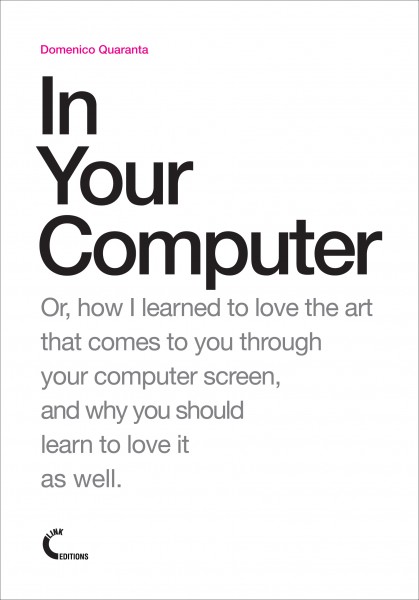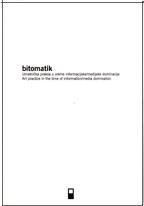Joasia Krysa (ed.): Curating Immateriality: The Work of the Curator in the Age of Network Systems (2006)
Filed under book | Tags: · aesthetics, art, collaboration, curating, database, exhibition, internet, internet art, labour, media art, museum, net art, open source, relational aesthetics, software art, technology

“The site of curatorial production has been expanded to include the space of the Internet and the focus of curatorial attention has been extended from the object to processes to dynamic network systems. As a result, curatorial work has become more widely distributed between multiple agents, including technological networks and software. This upgraded ‘operating system’ of art presents new possibilities of online curating that is collective and distributed — even to the extreme of a self-organising system that curates itself. The curator is part of this entire system but not central to it.
The subtitle of the book makes reference to the essay ‘The Work of Culture in the Age of Cybernetic Systems’ (1988), in which Bill Nichols considered how cybernetics transformed cultural production. He emphasised the shift from mechanical reproduction (symbolised by the camera) to that of cybernetic systems (symbolised by the computer) in relation to the political economy, and pointed to contradictory tendencies inherent in these systems: ‘the negative, currently dominant, tendency toward control, and the positive, more latent potential toward collectivity’. The book continues this general line of inquiry in relation to curating, and extends it by considering how power relations and control are expressed in the context of network systems and immateriality.
In relation to network systems, the emphasis remains on the democratic potential of technological change but also the emergence of what appears as more intensive forms of control. Can the same be said of curating in the context of distributed forms? If so, what does this imply for software curating beyond the rhetoric of free software and open systems?”
Contributors: 0100101110101101.ORG & [epidemiC] | Josephine Berry Slater | Geoff Cox | Alexander R. Galloway & Eugene Thacker | Olga Goriunova & Alexei Shulgin | Beryl Graham | Eva Grubinger | Piotr Krajewski | Jacob Lillemose | low-fi | Franziska Nori | Matteo Pasquinelli | Christiane Paul | Trebor Scholz | Grzesiek Sedek | Tiziana Terranova | Marina Vishmidt
Publisher Autonomedia/I-DAT, 2006
Creative Commons License
DATA browser series, 3
ISBN 1570271739
288 pages
PDF (14 MB, added on 2018-3-29)
PDFs (updated on 2016-12-12)
Domenico Quaranta: In Your Computer (2011)
Filed under book | Tags: · art, biotechnology, curating, internet, interview, media art, media theory, net art, new media, software art, technology, video games

This book is a collection of texts written by Domenico Quaranta between 2005 and 2010 for exhibition catalogues, printed magazines and online reviews: a pocket version of what the author would save from the universal flood, in a world without computers. It documents most of the fields of research he has focused on critically: from Net Art to Software Art and videogames, from biotechnologies to the debate around curating and the positioning of New Media Art in the contemporary landscape, and back to Net Art again.
This itinerary is traced through a selection of essays, monographic texts and interviews with artists and curators, in no particular order: from Eva and Franco Mattes to Casey Reas, from UBERMORGEN.COM to Oliver Laric, from Cory Arcangel to Tale of Tales, from Jon Ippolito to Gazira Babeli.
As the author writes in the introduction: «We are in the midst of a major change. At the end of the process, not only the way we live, work, travel and communicate, but also the political and economical structures and the social organization we are used to will probably be fundamentally different from how they are now. In art, this change will be complete when the way we make, circulate and understand art is completely different from the way we do it now; and when the way we understand the difference between copies and original and between art and non-art will have adapted to the new models created by the information age. The most we can do now is to take our time, adapt to our new living conditions, be aware of the process going on and look to the most radical propositions around for signals of what is to come. In the awareness that we probably don’t have to look that far: these signals are already here, in our computers.»
Translation and editing: Anna Rosemary Carruthers
Publisher: LINK Editions, Brescia 2011.
ISBN: 978-1-4467-6021-5
180 pages
Licensed under the Creative Commons Attribution-NonCommercial-ShareAlike 3.0 Unported License.
publisher
lulu.com
via Domenico Quaranta
kuda.org (eds.): bitomatik: Art Practice in the Time of Information/Media Domination (2004) [English/Serbian]
Filed under book | Tags: · capitalism, computer art, floss, internet, media theory, networks, software art, wireless networks

“bitomatik is a collection of texts, transcripts of lectures held at the New Media Center kuda.org between 2001 and 2004. The texts describe models of comtemporary artistic production which use different media as a means of expression. Drawing on the activist-artistic practice of Novi Sad in the sixties and seventies, a period of the neo-avant garde, the kuda.org Center has examined those phenomena containing an interdisciplinary and cross-media character. From the very outset, kuda.lounge has been a platform for discussion, argumentation, dialog and the contextualization of artistic practice, in the framework of which more than fifty presentations, lectures and workshops have been organized. Particular attention has been paid to communication and the exchange of ideas, primarily owing to the fact that the arts’ scene in Serbia during the nineties developed within a context of what is often called ‘Art in a Closed Society’, which resulted in a syndrome of self-referential artistic production. The Internet and the development of communication technologies formed the electronic backbone of social movements in the late nineties and the early part of this new century, and at the same time connected a smaller circle of Novi Sad artists (the Absolutely Association, Andrej Tišma, the Videomedia festival) which in spite of the odds established contact with the international scene, and brought members of this network to present their work in Novi Sad. International mailing lists such as Nettime, Syndicate and Spectre played a central role in this communication.
In inviting key names in media art and theory, kuda.org has attempted to offer the local public an insight into international contemporary artistic practise. The local population has had a chance to familiarize themselves with the work of leading international and local artists, theoreticians and arts’ groups such as Critical Art Ensemble, Bureau d’Etudes, Armin Medosch, and Inke Arns. Lectures and presentations within the framework of kuda.lounge are orientated towards researching new media related to social activism, media theory, and conceptual art, new-media “genres” such as net.art, software art, interactive art and generative art are explored .
The question of the so-called new media is quantitively identical to problems dealt with by the neo-avant-garde of the sixties and seventies, which conducted experiments with installations and video and electronic sound. These problems deal with the question of the relationship between medium and content, i.e. what’s new in new media. Media research is the history of researching communcation and extroversion and in itself simultaneously bears the political, seeking channels to address the masses and send a message. The avant-garde’s aspiration to penetrate society, to reach ground zero, and lead it in the utopian project of creating a fair society is closely connected to media research. The contents of this collection present different research and experiments in new media and a kind of manifestation of the artistic avant-garde at the close of the 20th century and the dawn of the 21st century.
These two elements; society as an object of intervention by an artistic project, and media research via which this intervention is to be carried out, are the basis of this collection of texts. This publication brings a cycle integrating debates and discussions on contemporary artistic practice to a close, and in a print medium presents them to a wider public.”
Contributions by Eric Kluitenberg, Darko Fritz, Armin Medosch, Inke Arns, Critical Art Ensemble, Bureau d’Etudes, and Raqs Media Collective.
Serbian title: bitomatik: Umetnička praksa u vreme informacijske/medijske dominacije
Publisher: Futura publikacije, Novi Sad, 2004
kuda.read series, 2
Creative Commons BY-NC-SA 1.0 License
ISBN 8671880273
168 pages
PDF, PDF (updated on 2021-12-11)
Comment (0)
